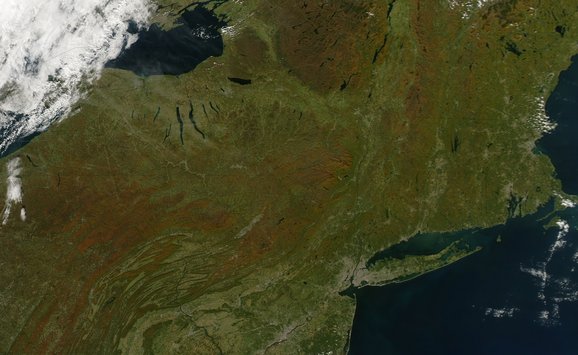The definition of open space—all land and water not covered by buildings—makes open space a question not of "how much," but of "where," and particularly "where" in relation to buildings and the people in them ... the critical question is how these structures are distributed. The same applies to the way clusters of buildings are distributed at such larger scales as the neighborhood, the group of communities, or the region.
The New York region provides me with the most striking example of the impact of lot size on the regional scale of open space ... The development of this metropolitan region, in gross terms, has spread outward in concentric rings. Important physical interruptions were dictated by the blessing of an interesting topography, especially of water, which comprises over a third of the region's area—principally the Atlantic Ocean, Long Island Sound, New York Harbor, and the Hudson River.
The circle of urbanization has grown steadily at a much faster rate than has the population. The radius of this circle was five miles in 1900, twenty-five miles in 1960, and may become fifty miles by 1985 unless present trends change and new policies are introduced. Recent studies by the Regional Plan Association show that two-thirds of all the vacant land in the region is zoned for half acre lots or larger. Should the zoning hold, twice the amount of land will be developed in the next twenty-five years as in the region's entire history.

Street-scale open space is completely bound up with urban activity and buildings. The architect who creates the buildings automatically, but not often deliberately, creates thins open space.
Here we look to urban design only to be greatly disappointed. The paucity of attempts to relate buildings by design is a serious failure across the nation. The world abounds in examples where buildings and their related open space were planned together, but in our country a few well-designed urban spaces and subdivisions—including, among others, Radburn, Chatham Village, Chase Manhattan Plaza, some aspects of Penn Center—stand out as stark exceptions. This stems in part from outmoded legal and economic concepts which demand a publicly owned street bordered by rows of individually owned lots, and which ignore the more basic consideration of what kind of open space people like to use with their neighbors and what kind with their families.
The tradition of what is public and what is private has largely denied us the open space benefits possible in"clustering" or "density zoning." Clustering ... consists merely in taking the number of dwelling units permitted by the zoned minimum lot size and distributing them on smaller lots, so that while the overall density is unchanged, some larger, more natural chunks of land are left open for the common use ... But the fly in ointment is the question of who owns the open space. The builder usually doesn't have enough incentive to keep it or to organize a sharing of ownership among the new residents (an important exception is Eichler Homes in California who are producing well-designed and useful common areas and facilities and inducing, homeowners to participate jointly in their ownership and operation). The community won't assume the "maintenance" and other responsibilities it entails, although it cheerfully accepts streets. It is not a simple problem, but the solution clearly lies in our ability to find ways to combine shared use of open space with shared ownership of it.—Stanley B. Tankel, planning director, Regional Plan Association, New York City.





